

Building
A Bright Future
Shortly after Mrs. Harriet Symes began teaching school in 1846 at her log home more families settled in the township. Efforts quickly got underway to address needed academic opportunities for Sparta youth. On January 11, 1847, the first meeting to organize a school district took place. Before long other one-room school houses sprang up around the Township.
At that time, schools were primarily funded by families who paid tuition for their children to attend. Some students provided wood for the stove or other services such as the responsibility to shovel the walk and light the fire in the wood stove on cold mornings. Sometimes an arrangement of room and board for the teacher, if needed, was bartered for the tuition.
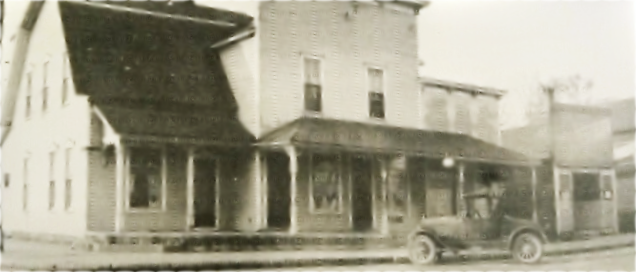
Nash School where, in 1849, school was held in the center section of the building. The photo shows the building as it later appeared when it was used as a storefront.
Among these early schools was Nash School on East Division built in 1849 between Mill (Union) and Main (State) Streets on property donated by Jonathan Nash in downtown Sparta which was briefly known as "Nashville". It was a small one room school, but had the distinction of being the community's first "public school". In addition to the Nash School, the 1855 Sparta Township map also included Mrs. Symes' school, Myers School, and others located at Ballard's Corners and Englishville. On Oct 11, 1859, the first teachers contract was signed.
Sparta's growth required a larger school and the board of education which consisted of Moderator Lorenzo Dennison, Director A.B. Cheney, and Assessor J.E. Nash approved the building committee's recommendation. In 1875, a two-story school was built on the north end of town constructed of white bricks. Administrative duties were assigned to teachers, and the high school began with a total of three: teaching Principal A. Hamlin Smith, Assistant Ida Green, and an unknown third teacher, who was hired later, rounded out the staff. Additional teachers taught the lower grades.
As described by the 1881 Kent County Atlas:
- SCHOOLS OF SPARTA. The township schools have advanced, within a comparatively short space of time, from a most primitive condition to a very respectable place among the schools of the county. This encouraging fact bears in itself a very high testimonial to the character of the inhabitants. There are 568 school children in this township, taught by 15 teachers, in eight school-houses, two of which are brick and the rest frame. Value of school property, $8,600; total salary of teachers for the year ending June 30, 1881, $2,068, and total expenditures, $4,233.01.
When Julia, the wife of Sparta High School Principal A. Hamlin Smith, gave birth to their second child he decided to commemorate the special event with something more than just a typical box of cigars to hand out to his friends and acquaintances. Instead, he decided to celebrate with a monumental exclamation point: maple trees!
In the weeks leading up to the dedication of the second high school in 1901, he related the story in a letter penned to Miss Weltha Faye Walcott who was preparing the event program and had requested information about the first school. The letter was later published in The Sentinel Leader on 10 June 1970, and an excerpt follows:
- The trees on the lot were set on April 21, 1882. The work was done by the "big boys" of the school, among whom I remember Henry Walcott, Henry Sleeper, Will Empey, James Kennedy, Allen Martindale, Morse Olmsted, and Orris Woodin. Those were the biggest boys ever in my school. I think, too, that George Walcott was there part of the term.
The day the trees were set, my younger son was born. I recommend the tree-setting enterprise. Think how easily Lisle - my son - can remember his age. All he needs to do, is remember when those trees were set.
...I wish that I might be in Sparta to witness the dedication of school building No. 2. But I feel safe in saying that the new building will never shelter any brighter minds nor warmer, truer hearts that has the old one.
Yours very respectfully,
A. Hamlin Smith
Those who helped to plant the small grove of maple trees were former students and local men who, at that time, were in their twenties and early thirties. Most were farmers, along with a carpenter, a bookkeeper, and a lumberman. One among them, James Kennedy, was inspired by his schooling at Sparta. He followed in the teaching profession, which was a lifetime pursuit, and eventually he became a professor.

The first white brick school as it appeared in late 1882. If you look closely, or zoom in, you will see many of the large maple trees planted earlier that year by Principal A. Hamlin Smith and his crew of Sparta "big boys".
Weltha (Walcott) Carlson's son, Charles Carlson of Detroit, passed Principal Smith's letter on to his uncle, Fred G. Walcott, who added one of his own and shared both with the Editor of The Sentinel Leader, Barry Brand, to publish.
- What Mr. Smith refers to as School No. 2 was built during the summer of 1900. I and my twin brother Frank entered the kindergarten that fall. Our sister Weltha was a junior that year, and it seems quite obvious that she had been asked to collect the information concerning the history of Sparta High School in preparation for the dedication of the new building, probably held in conjunction with the commencement exercises of June, 1901.
But the new building was not available that first year until after the Christmas vacation. Meanwhile, the kindergarten and first grade met in the United Bretheran Church across the street. These classes were taught respectively by Miss Anna Huisinga of Zeeland and Miss May Kingsbury (later Burke) of Cassopolis. I remember distinctly our delight on entering the new building on that first day. Our room was bright from the big windows and warm from the big tier of steampipes extending along the two outside walls. Instead of the long tables and the chairs we had in the church, there were symmetrical rows of new desks; and over all was the pleasant smell of newly oiled floors and fresh varnish.
During the construction of the new school, the old one had been divested of its brick veneer and moved off to the north of the old site, so that classes could continue in the old shell until the new building was ready. It was not demolished until the following spring.
The new school consisted of eight rooms, four on each floor, with the main entrance in the center of the building under the bell tower. Downstairs the kindergarten had the northwest room; the first grade and a part of the second had the southeast; the other part of the second grade and the third grade had the southwest; and the fourth and fifth grades had the northeast room. Upstairs, the sixth and seventh grades shared the southeast room, and the eighth grade had the northeast. The west side of the upper floor was divided unequally between a large high school session room on the south and a smaller recitation room on the north. Then there was a tiny library room crowded in between the recitation room and the stair corridor.
In his letter, Mr. Smith is reporting memories of events which occurred some twenty years earlier. In his list of the "big boys" who helped to plant the maple trees, there seem to be some obvious errors. Henry Walcott, my father, was born in 1853, and would have been then, in 1882, 29 years old. I am sure that his formal education and that of my mother consisted only of a few months of elementary work, taken during the winters, when they could be spared from the farm work. Surely it continued only over the years of their childhood and early youth.
There were no grades as such in those days, and the children began their lessons in the late fall where they had left off in early spring. The reading books were arranged merely in numerical order, such as Harper's First Reader, Harper's Second Reader, etc. The last in the series, I think, was Harper's Fifth. The numbers did not mean grades. I have examined these books and find that they progressed into very mature materials such as would appear now only in the upper years of high school. My impression is that my father must have drunk deep from this Pierian Spring. I remember many occasions when he would sit in our little farm home on an evening, declaiming the poetry that he must have learned so many years ago. It might be Lord Byron's The Destruction of Sennacherib:
The Assyrian came down like a wolf on the fold,
And his cohorts were gleaming in purple and gold;
The sheen of their spears was like stars on the sea,
When the blue wave rolls nightly on deep Galilee.
Or Fits-Greene Halleck's Marco Bozzaris:
At midnight, in his guarded tent,
The Turk lay dreaming of the hour
When Greece, her knees in suppliance bent,
Should tremble at his power.
He discovered a grand oratorical power in these things, and he recited them with great feeling. These memories have taught me that even the rudimentary learning then available in the ole-room rural schools of those early days was a thing not to be despised - that the love of learning, then and now, is probably almost universal in the human mind.
George Walcott, also mentioned by Mr. Smith, was my father's older brother, the father of Ohlin E. and Colin R. Walcott. I doubt very much whether he ever attended Sparta school either. But these men might have helped out with the tree planting. the only member of my father's generation to graduate there was the youngest sister, Eva Walcott, who later married William Kellogg, a brother of Frank Kellogg, who kept the barbershop.
The trees planted on that auspicious day had grown into fine large maples in my time. They extended in a double row, one on either side of the walk, from the entrance to the street. There were several others on either side, too, and altogether they made a beautiful shady grove for us to play in.
For many years my father was a member of the Board of Education, and three of his children eventually came to teach in the Sparta schools. Alice May Wylie taught the fifth and sixth grades for one year before her marriage. Weltha F. Carlson was for many years the principal of the junior high school. I served as principal of the high school from 1925 to 1927. My memories of the school are deep and intimate.
Sincerely yours,
Fred G. Walcott
A. Hamlin Smith
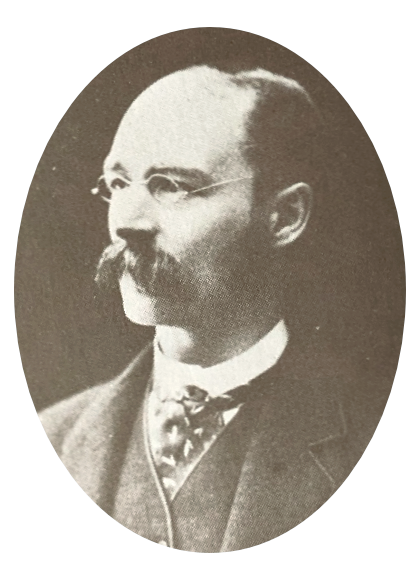
Principal A. Hamlin Smith
The Smiths were joined in matrimony on October 30, 1874, at Grand Rapids; Alonzo H. Smith, born at Cleveland, in Oswego County, New York, and Julia Ethilyne Gardner a native of Lowell, Kent County, Michigan. The enumeration of the 1880 Federal Census placed A.H. and Julia Smith at Sparta, along with their first born son, Carl H., who was one year old at the time. They resided in the Village of Sparta next door to Charles E. Loomis, the gun smith.
In 1884, the family left Sparta and in 1900, they lived at Lansing where Hamilin was employed by the state as chief clerk of the Department of Public Instruction. Lisle followed in his father's footsteps to become a teacher and in 1910, was a member of the profession at Calumet in Houghton County, Michigan.
Fred G. Walcott
Life began for Fred and his twin brother, Frank, on September 8, 1894, at Sparta. Sons of Henry Elijah and Charlott "Lottie" Elizabeth (Thompson) Walcott, the twins were the youngest of five children which included siblings Alice, Weltha, and Asa.
After Fred's high school graduation in 1913, his father died which left the son shouldered with the responsibility to manage the family farm. He raised registered Hampshire Down sheep, Plymouth rock chickens, and sold rosen rye. Besides his farm duties, he was active in the Sparta Co-Operative Association Inc., the Grange, and the Farm Bureau. His aptitude for teaching became evident as he spoke at Grange gatherings on various topics such as raising beef or budgeting.
Fred was an accomplished violinist and often performed at local gatherings or events, usually in duets or ensembles with fellow graduate members of the Sparta High School orchestra. His civic involvement in the community included a position as the Sunday School Superintendent at the Baptist Church.
In 1919 Fred married Edith Carlson, a mathematics teacher from Detroit. When the 1920 US Census was enumerated they lived at Sparta on the family farm, north of town. Shortly thereafter, Fred and Edith were blessed with the birth of two children: John and Virginia. He decided to pursue the teaching profession and in 1925, while operating the family farm, Fred earned his education degree at Grand Rapids Junior College. He landed a position at his alma matter where he taught English and became the principal at Sparta High School.
Fred continued his education, taking summer school courses at the University of Michigan. By 1928, he relocated to the Upper Peninsula employed as an English teacher at Negaunee in Marquette County, Michigan and two years later he completed his masters degree. Fred accepted a position with the University of Michigan in 1930 to instruct at Ann Arbor. Eventually, he achieved dual Professorships of education and English. A highlight of Dr. Walcott's notable career included one year where he taught at Sheffield, England as a participant in the University professor exchange program. Among his prolific publishing credits were ten junior and senior high school English textbooks. Professor Walcott's distinguished career came to a close in 1965 when he retired.
Fred Walcott Will Speak At Next P.T.A. Meeting
The Sentinel-Leader
published on 21 April 1938
Tuesday evening, April 26, will be the last meeting of the current year for the P.T.A. An especially fine program is being prepared. It is hoped that members and friends will co-operate in making this one of the best attended meetings of the year.
A former Sparta boy, Fred Walcott, will be the speaker. Mr. Walcott graduated from the local school in 1913, returning several years later as principal of the high school for two years. Two years of teaching at Ispheming was followed by further work at the University of Michigan at Ann Arbor, where he has been since, being head of the English Department of the University High School for the past few years.
A leave of absence has been granted Mr. Walcott this semester to finish a text book on English, to be published by Scot-Forsman Company. Mr. Walcott is looking forward to greeting his many friends and former pupils after the program. Mrs. Clare Wilson, Jr., will have charge of the special musical numbers. O.E. Balyeat will act as chairman.
Decision to Build
Sparta village had become home to 1,126 residents by 1900, up from 904 reported in the 1890 US Census. Steadily the population increased so schools were enlarged and new ones built, yet the rise in pupil numbers continued to outpace the space available to accommodate them. A publication entitled The School Record dated May of 1900 stated, "Sparta's schools are so crowded that no new pupils can be admitted at the beginning of the spring term, but will have to wait until next September to come in."
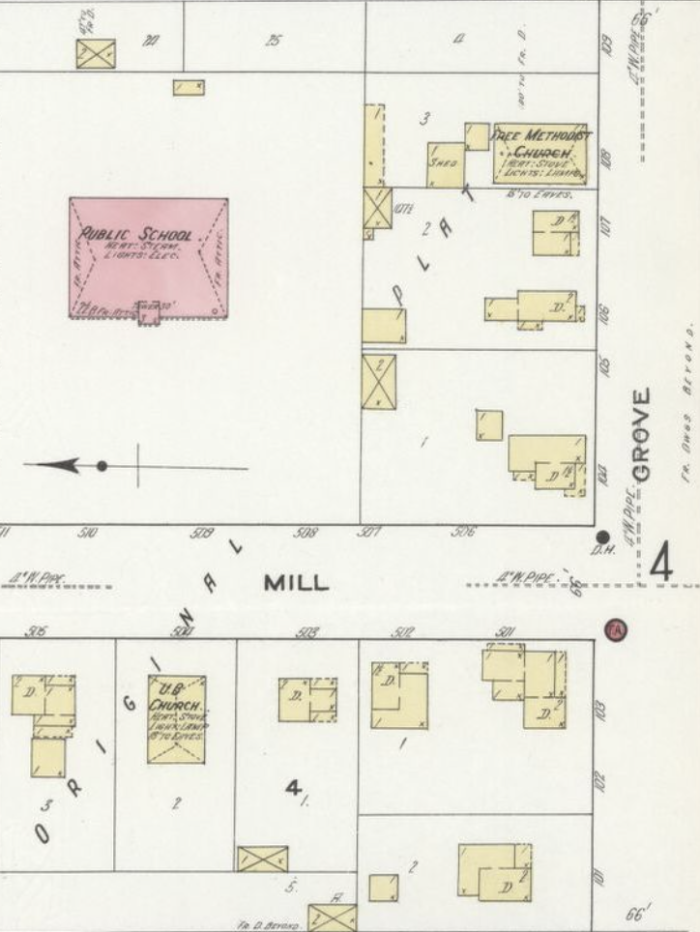
Plat map prepared by Sanborn Fire Insurance in 1904 of the Sparta High School neighborhood
As the century mark approached, the Sparta School Board already recognized the need for a larger, more substantially built school, one which would meet student needs as it better prepared them for the challenges of their modern world. The board members included: Charles F. Johnson, George W. Dunn, Hugh Alexander Montgomery, Frank T. Roberts, and John W. Hallack. The community's support and willingness to provide for the educational needs of their children was evident in the construction of the school facility and spoke clearly of the character of the people of Sparta.
Charles F. Johnson
Charles was born in Smoland, Sweden, and immigrated in 1869 to the United States as a young man of twenty-three. He sailed from Gottenburg to Liverpool, England, then embarked on the fourteen day trip across the ocean to New York by steamer. Once he arrived at Chicago, he came directly to Sparta Township and found work as a lumberman which paid $12 a month. Eight years later, he married Sophia Fag, who was also born in Sweden. They started a family and established a farm. By 1900, Charles had served twelve years on the school board. According to his biography published in the 1900 City of Grand Rapids and Kent County, Mich. Prominent and Representative Citizens by the A.W. Bowen & Co., Charles advocated for "the employment of the best teachers the board could afford."
George W. Dunn
Born at Ensley, Newaygo, Michigan, on 26 Sep 1865, George was the son of Lewis and Nancy (Hunter) Dunn. Shortly thereafter, the family relocated to a farm near Lisbon in Sparta Township. He graduated from high school at Sparta. On Valentine's Day in 1889, he married Libbie McCune, the daughter of William and Mary (Austin) McCune. George was a farmer, became a trustee for Peoples Bank, and served on the Sparta School Board. Previously, his father was a member of the school board for fifteen years.
Hugh Alexander Montgomery
Canadian-born Hugh Alexander Montgomery began life on 4 July 1853 at Northumberland, the offspring of Irish immigrant parents. He immigrated to the US in 1863 with his family and was naturalized at Pennsylvania before he arrived a few years later in Kent County, Michigan. Effie Cummings, daughter of Edwin and Hannah, was Hugh's first wife. He was widowed and married Hattie Estella Hoose. Hugh's properties were located just east of High Lake and south of Thirteen Mile Road where he farmed in Algoma Township. Described as a "stanch friend of public education," who "believes in securing the best teachers available," Hugh became a member of the Sparta School Board of Directors in 1894 and was an Algoma Township Supervisor. Later he was elected as the Kent County Register of Deeds.
Frank T. Roberts
The town of Phelps in Ontario County, New York was the birthplace of Frank Tonman Roberts, the only son of James T. and Elizabeth A. (Bigelow) Roberts. On the 26th day of June in 1854, he took his first breath of air. At the young age of nine, the boy left his formal school education to learn his father's trade; that of a machinist and blacksmith. During this time, he continued to study academics at home in the evenings. A bright boy, he completed his apprenticeship and became a journeyman in just three years under the elder Roberts' tutelage.
Frank worked as a mechanic in eastern Michigan for fifteen years, then tried his hand at other lines of business. Eventually, in 1875, he operated his own store in Grand Rapids. Mary J. Chapel caught his eye and captured his heart. Their marriage took place on 6 April 1881, at Rockford, Michigan. The bride was born at Ada, Michigan, the daughter of M.D.L. Chapel and Lillie McPherson, a Scottish highlands lass.
Life was good until he lost everything to a devastating fire. Financially broke, but not broken, in 1885 he decided to start anew at Sparta. Frank not only achieved success and earned himself a good reputation in his new blacksmith business where he also built wagons, carriages, and provided farrier services, but also with his large fruit farm. By 1900, Mr. Roberts had served the community for several years on the school board.
John W. Hallack
The editor and publisher of the Sparta Sentinel, John W. Hallack, was known as a strong supporter of education. He served several years on the Sparta village council, was a trustee of the Free Will Baptist church in Sparta, and in 1900, a member of the school board for six years. His biographical sketch is located in the Newspapers section.
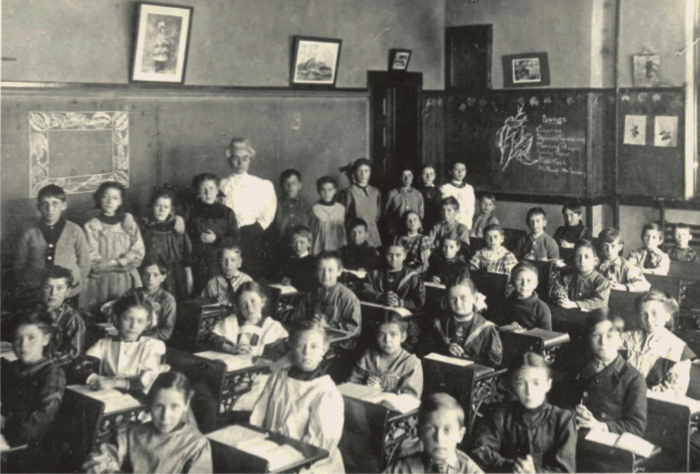
Elementary class, teacher and students unidentified--courtesy of the Grand Rapids Public Library, Godfrey Anderson collection 33
The timing for the new school couldn't have been better as the age of electricity had just arrived at Sparta!
The Belding Banner printed an item in their 27 April 1899 newspaper with the announcement: "The hustling village of Sparta is to be lighted with electricity a franchise having been granted to J.L. Hisey for a period of ten years. The lights are to be 1200 candle power arc and two 32 incandescent lamps." Jacob Hisey was part owner with Charles Jackson of the Jackson & Hisey elevator at Sparta. By June, the Belding Banner reported: "Sparta is now reveling in electric street lights the old lamp system having been suspended last week with a new electric plant." And The Unionville Crescent chimed in to say: "The old oil lamps at Sparta which have done duty lighting the village streets for some time have been relegated to the ash heap, the new electric lighting plant having been completed and put into operation."
Sparta's new public school was constructed in 1901 of cut stone and red brick on the same site as where the white brick school had stood on Mill Street, now known as North Union. It consisted of two stories plus a basement with daylight windows and attic space in a rectangular footprint which measured 70' x 90' long and was adorned with a stately bell tower that stood 30' tall above the front entrance. Classrooms were generously lined in tall double hung glass windows for ample fresh air and natural light. Wood slat floors, plaster walls, and large blackboards further enhanced the educational environment. At a time when wood heat and oil lamps were still commonly in use, the new school building was heated by steam and outfitted with modern electric lights. Although most Spartan alumni warmly think of - and refer to - the 1901 structure as the "Old Sparta High School", originally and throughout most of its history, it served pupils of all ages; kindergarten through twelfth grade.

Mr. O. E. Balyeat's chemistry class in 1913 was located in the basement level of the high school. In addition to teaching, he took on the position of Superintendent from 1909-1943. A remarkable man, his biography is featured among the 2014 Sparta Notables. Pictured are: Mr. Balyeat, Robert Fonger, L.D. Myers, Clifford Gillett, Olga Hilton, Era Haines, Wilfred Cummings, Carl Bradford, Oscar Johnson, Fred Walcott (a future teaching principal of Sparta High), Frank Walcott, George Nelson, D.J. Moore, and John McInis.

Sparta High School class of 1920, left to right, first row: Sally Carlson, Mary Saur, John Parks, Merle Hodgins, Marietta Blossom, Nathan Snyder, Edna Johnson, and Burnadette Dutmer; second row: Donna Meeker, Herbert Miller, Margaret Fox, Earl Ryder, Lena Dargie, Lawrence Johnson, Leona Montgomery, Howard Gillett, and Thelma Kellogg.
Already standing for two decades by the time students were settled into their brand new classrooms, Principal Smith's small grove of maple trees on the front lawn of the first school were an amazing gift to future generations of students. As they grew, the majestic maple trees shielded classrooms from afternoon heat in the summertime as children laughed and played "tag" in the yard. Backlit by golden sunlight, a delightful kaleidoscope of autumn leaves danced in the breeze on warm October afternoons. Throughout the winter, daydreaming students could muse the structure of the skeletal trees and how fresh fallen snow gently caressed their branches. As days warmed in springtime and green buds burst into leaves, the maples provided a shady spot to relax, read a book, and hear the songbirds' cheery serenade.
In 1910, the first classrooms addition was built on the south side of the red brick school to perfectly match the existing facility.
By 1914, Sparta High School had organized both girls' and boys' basketball teams. The Belding Banner reported the newly formed teams were "now on the lookout for games" and their season would be opening with "a game with the Independent team". The hardy Sparta teams practiced and played their home games at an outdoor court - during the winter and early spring, no less.
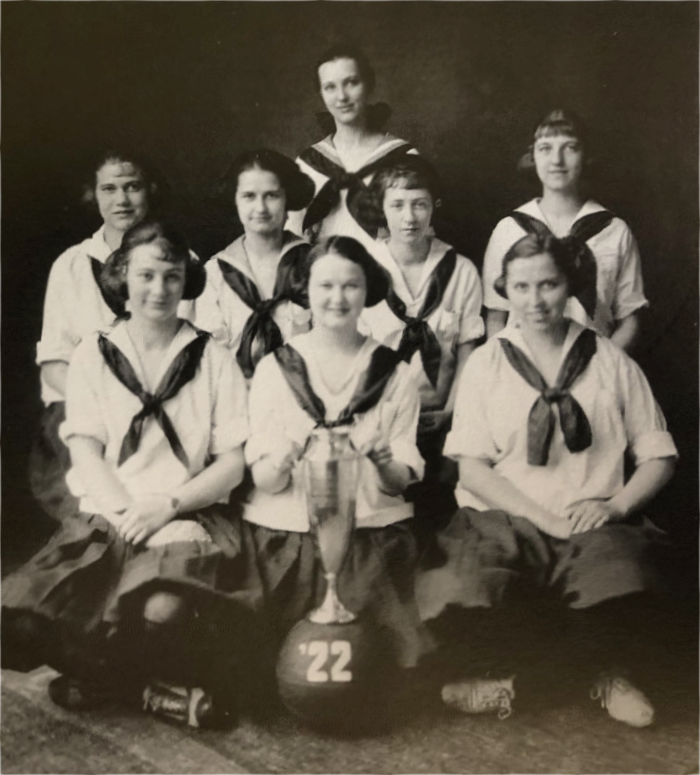
1922 girls basketball team, left to right, first row: Alma Anderson, Gladys Saur, Nina Stauffer; second row: Nyla Witt Feerick, Althea Klenk, Leah Rice, Lillian Culver Bradford; third row: Clara Fox.
On March 27th, 1919, at least six members of the Sparta High School girls' basketball team traveled to Lansing for the state championship to be held at the M.A.C.'s gymnasium (the Michigan Agricultural College was the forerunner to Michigan State University). The group included: team Captain and centers Symes and Bright, forwards Rice and Holt, plus guards Johnson and Taylor. At that time, girls basketball teams used two centers. In the lead up to the title game, the Lansing State Journal reported the Sparta girls had acquired a reputation of having a "fast squad of girl basket shooters." Throughout the season, both teams played nine games and were undefeated. Teams which challenged Sparta's girls that year were: Grand Haven, Coopersville, Kent City, Grand Rapids, Alumni, Rockford, and Grandville. The Sparta hoopsters scored a total of 245 points to their opponents' 59, while the East Lansing girls put 418 points on the scoreboard to their opponents' 129 combined total.
The newspaper reported prior to the game the East Lansing girls had practiced on the M.A.C. court, an opportunity not afforded to Sparta. When faced off against the East Lansing team, who clearly held the hometown advantage, Sparta girls played a tough game but were out scored 29 to 10.
In the April 4th, 1919, issue of the Lansing State Journal, a report from Sparta stated a second game of the championship series was expected to be played at Sparta and they would see "the largest crowd that has ever witnessed a basketball game here" to be in attendance. After the first match-up, "The East Lansing team is reported to have claimed the state honors on the strength of the first game which was played at East Lansing and won by them 29 to 10," the newspaper article explained. "The local team is not willing to concede this point for they say when arrangements were made for the series it was agreed that one game should be played at East Lansing and one here." No date had been set for the second game at Sparta, but it was expected to take place the next week. However, it doesn't appear the second series match up ever materialized so the "series" ended up as an after-the-fact winner-take-all single game.
Battle Creek's girls basketball team was also a contender for the state championship title with a 9-0 win record, but ultimately they flat out refused to play the East Lansing girls.
Winners never quit and quitters never win - even when they get the dirty end of the stick. The Sparta team's perseverance and hard work were finally rewarded as they earned the championship trophy for the 1922 girls basketball season. In 1925, a gymnasium, which doubled as an auditorium, along with several new classrooms were constructed on the north side of the 1901 structure. At last, Sparta basketball teams would have a proper indoor court!
Sparta School Is Music Center
The Unionville Crescent
published 28 Jan 1927, Unionville, Michigan
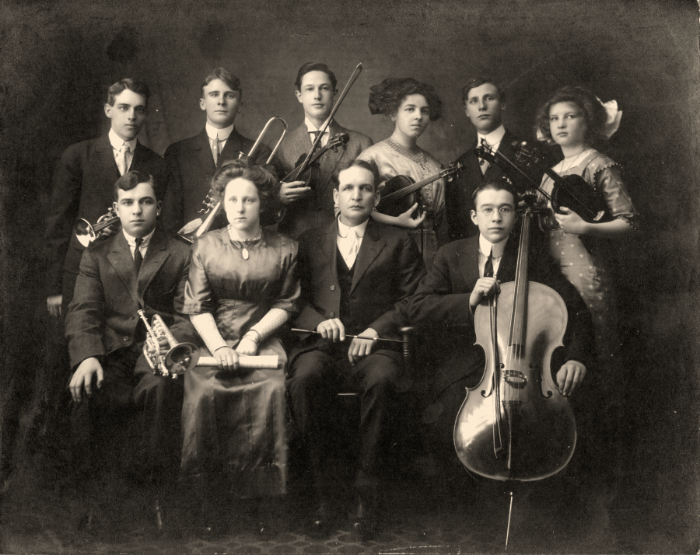
The 1913 Sparta High School orchestra, left to right, top row: Loren Gardner, Frank Walcott, Kenneth Coville, Ruth Beacon, Fred Walcott, Quida Brown; bottom row: D.J. Moore, Olga Hilton, V. Richtee, Karl Bolender.
Through the efforts of Supt. O. E. Balyeat in organizing courses in music in the schools this year pupils have been given added opportunities to get musical instruction both vocal and instrumental. A number of groups have been organized and these are under the direction of leaders well qualified for the work.
The high school chorus of 90 voices has been making good progress under the direction of Mill Phillips. Work on the operetta, "The Gypsy Rover" now is going forward with daily practice.
A senior band was organized at the beginning of the year under the leadership of Herman C. Johnson of Grand Rapids, assisted by Jerry Van. William Bartlette also has been of much assistance. The band is making regular appearances at the basketball games.
A junior band has also been organized for those just learning to play instruments.
Another organization that renders good service in the community is the high school orchestra, largely under the direction of Fred Walcott. Jerry Van of Grand Rapids gives orchestra instruction to the group once a week.
The Boy's Glee club, directed by Miss Phillips, also is making a hit at high school assemblies and other school events.
A Meaningful
Education
With a new school year set to begin in just a few days, The Sentinel-Leader published a news item entitled: ANNOUNCEMENT OF ORGANIZATION, SPARTA HIGH SCHOOL which appeared in the 6th of September 1934 issue.
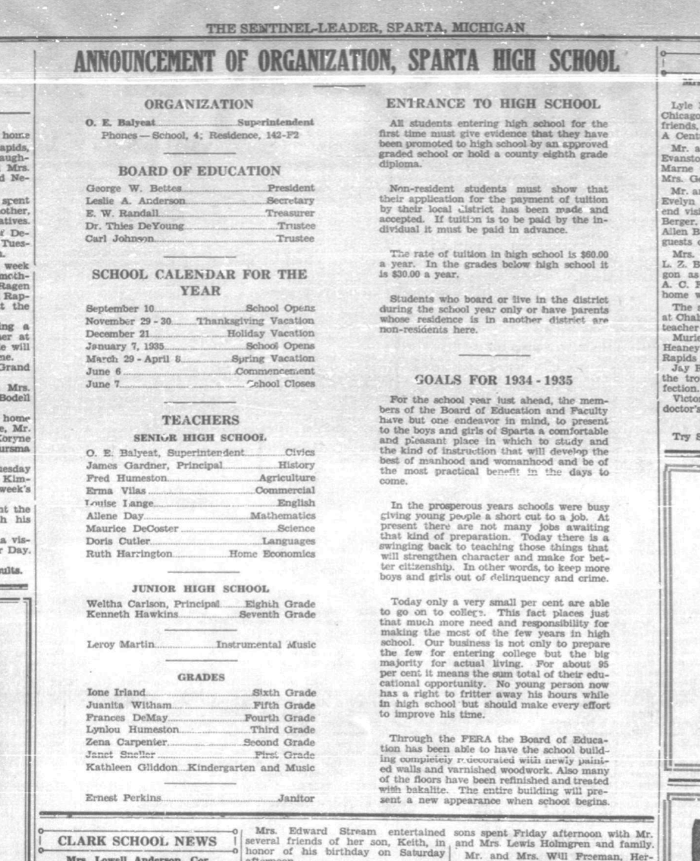
On 6 Sep 1934 The Sentinel-Leader published an annual start of the school year informational item--courtesy of Sparta Township Historical Commission's Newspapers database
The elementary grades, kindergarten through sixth, had one teacher per grade level as did junior high for seventh and eighth grades. Sparta alum, Weltha (Walcott) Carlson, was the Principal and she taught eighth grade.
Superintendent O.E. Balyeat taught civics class at the senior high while Principal James Gardner instructed history courses. Seven other teachers rounded out the staff for these subjects: agriculture with Fred Humeston, commercial with Erma Vilas, English with Louise Lange, mathematics with Ailene Day, science with Maurice DeCoster, languages with Doris Cutler, and home economics with Ruth Harrington, along with LeRoy Martin for instrumental music.
Five years into the hard times and uncertainty of the Great Depression, many had despaired and given up hope. The economy was in turmoil and for most the future appeared bleak. The stated GOALS FOR 1934-1935 embodied a realistically honest approach to how Sparta High School would navigate these rough seas.
- ...In the prosperous years schools were busy giving young people a short cut to a job. At present there are not many jobs awaiting that kind of preparation. Today there is a swinging back to teaching those things that will strengthen character and make for better citizenship. In other words, to keep more boys and girls out of delinquency and crime.
Today only a very small per cent are able to go to college. This fact places just that much more need and responsibility for making the most of the few years in high school. Our business is not only to prepare the few for entering college but the big majority for actual living. For about 95 per cent it means the sum total of their education opportunity. No young person now has a right to fritter away his hours while in high school but should make every effort to improve his time.
Weltha Faye (Walcott) Carlson
Weltha was born on 2 Oct 1882 at Sparta to Henry Elijah and Charlott "Lottie" Elizabeth (Thompson) Walcott. After graduating from Sparta High School in 1902, she became a teacher the following year at Bass schoolhouse, Sparta district 12, located in the northeast corner of the township near the intersection of Long Lake Drive and Indian Lakes. She remained at that post during the 1904 school year. Weltha married Reuben Carlson, a farmer who was born near Lisbon and their wedding was on 28 Dec 1904 with Rev. Maynard of Sparta's Free Will Baptist Church officiating. In 1905, Weltha taught at the Sparta district 1 schoolhouse, locally known as the Spangenburg School.
The couple purchased property and settled into married life at their farm in Tyrone Township. Two sons, Floyd and Charles, joined their family. On June 30th, in 1918, tragedy struck the young family as Reuben died of Pulmonary Tuberculosis, a disease he suffered with for two years.
As a single mother raising two sons, Weltha rose to the challenge. In 1919 and 1920, she taught school at Clark schoolhouse in Tyrone district 2 located in the southeast corner of that township. She was hired in 1921 to teach at Sparta district 2, the school built in 1901 from where she graduated, in the village. As the 1930 US Census was recorded, Weltha and her sons lived in the village of Sparta where she taught while the older boy, Floyd, at nineteen, was listed as a cabinet maker at the furniture factory. Deservedly, she attained the position of a teaching junior high principal which speaks well of her work ethic, strength, care for her students, and dedication to her profession. Admired and respected by the community, in 1937, she was elected to the Sparta library board.
In 1940, Weltha and her youngest son lived on River Street in Sparta as he attended college and she still taught school. Charles, his family, and Weltha resided at Detroit in 1950 where he was employed as an interstate railroad engineer. She passed away on 5 Aug 1954 at Detroit after a lingering illness.
Prosperity
and Growth
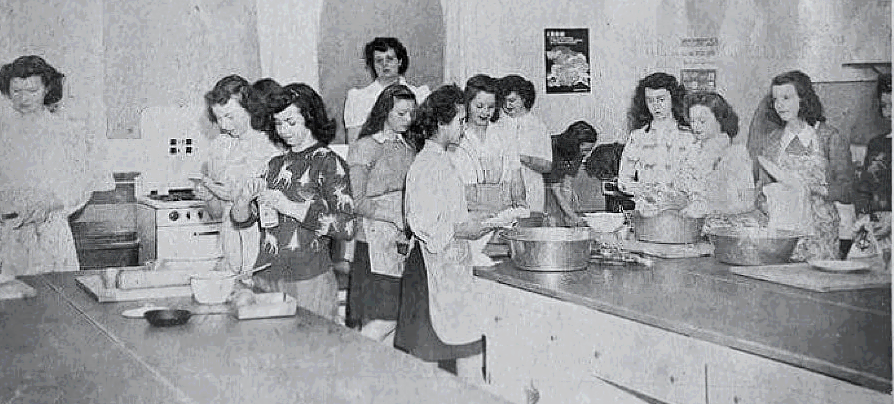
Miss Muriel Burman's home-ec class in 1946, also referred to as the homemaking department.
Continued growth required another expansion of several more classrooms in 1936-1937 to keep pace with the steadily increasing population of students and their educational needs. This enlargement became the second addition to the south side of the original school.
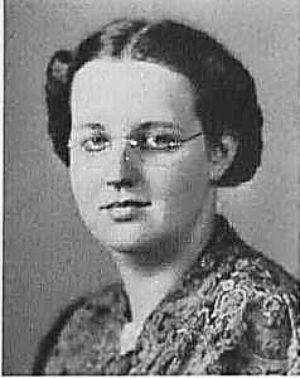
Miss Muriel Burman in 1939 as a senior at Albion College.
Included as part of that construction project, the original central entrance area beneath the bell tower facing North Union Street was enclosed and transformed to serve as the home economics classroom.
Muriel June Burman
Muriel was born on 30 June 1917, the daughter of Samuel R. and Mabel H. (Doran) Burman of Portland in Ionia County, Michigan. She graduated with the class of 1935 then Muriel went on to study home economics at Albion College. Following the completion of her studies in 1939, she was hired to teach briefly at Whitewater in Grand Traverse County and at Martin in Allegan County prior to her employment at Sparta High School. In 1950, Miss Burman taught the home economics class at Dowagiac, in Cass County, Michigan, and remained until she retired in 1981 after a forty-one year career in teaching.
Once again, construction took place, this time during 1949-1950 as well as in 1954 to create a new single level centralized elementary school for youngsters who resided within the village limits which was located to the east of the original school building. Kindergarten through sixth grades moved into the new sections while the two-story structure was dedicated to 7th-12th grades and became a junior-senior high school. The entire complex continued to serve Sparta students from kindergarten through twelfth grades, but now with separate facilities dedicated to each particular educational level's needs.
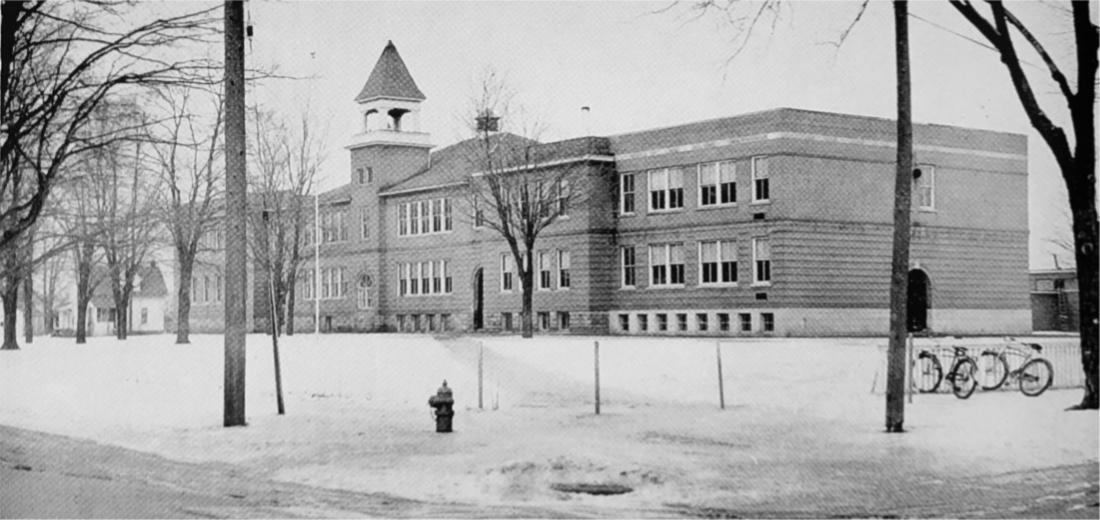
Sparta High School in 1949
Sparta students frequently relied upon the Carnegie Library, which opened in 1917, just down the street. The original upstairs library at the high school was quite small and as the lower grade additions came about, a larger school library was included.
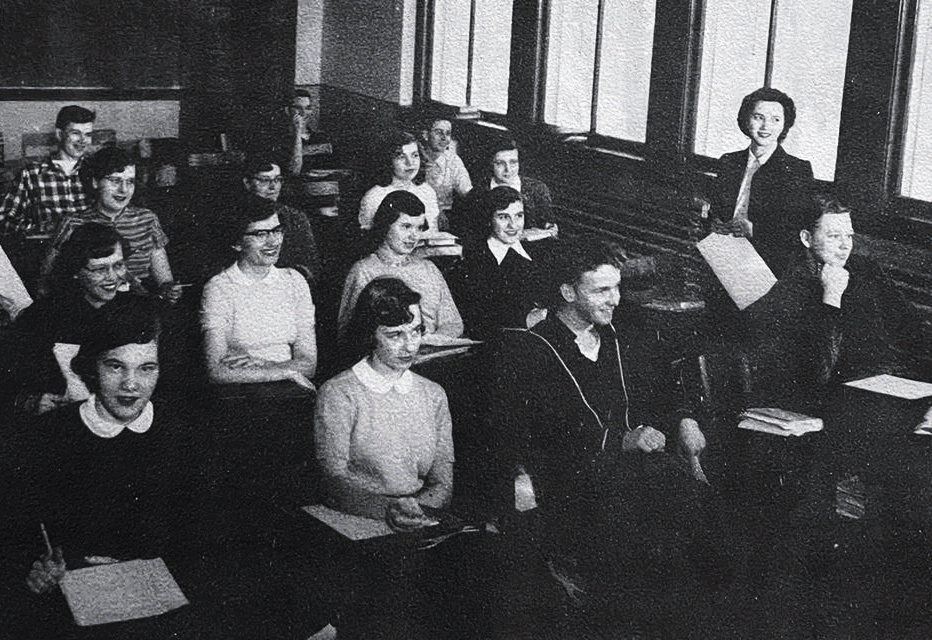
A 1952 mathematics class taught by Mrs. Elizabeth LaVine.
Back in the day, students brought their lunches from home in a brown bag or metal lunchbox. Since there wasn't a cafeteria, they ate the meal in classrooms seated at their desks - unless they lived close enough to walk home for lunch, eat, then return in time for their afternoon classes.
William and Elizabeth (Marshall) LaVine
Elizabeth Mae (Marshall), who went by Betty, was born at Highland Park, Wayne County, Michigan on 28 April 1927, the daughter of George V. and Viola (Schoen) Marshall. She graduated from Grand Haven High School and Albion College, where she majored in mathematics.
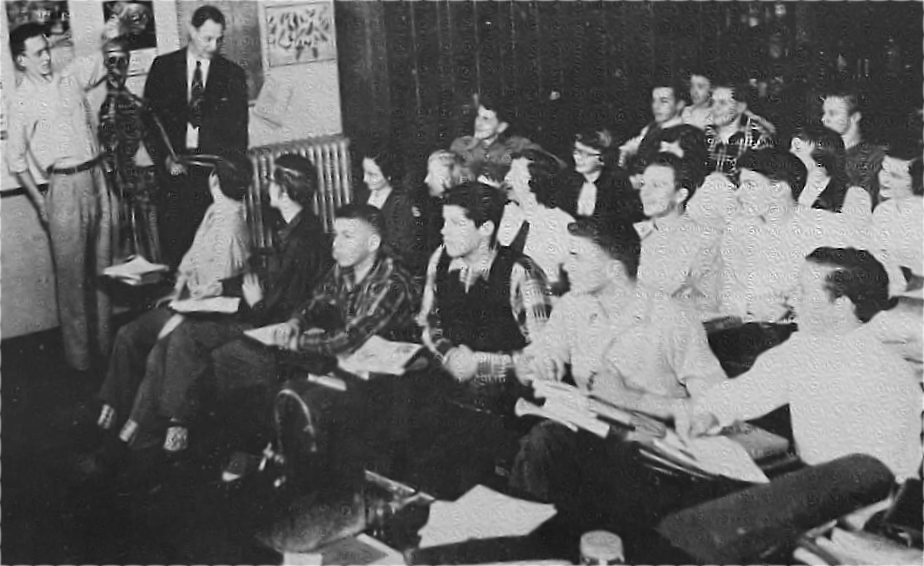
Mr. William LaVine's 1952 science class at Sparta High.
Elizabeth married William Stevens 'Bud' LaVine, the son of Hilding Edwin and Mabelle Jane (Stevens) LaVine on 18 Aug 1951 at Grand Haven in Ottawa County, Michigan. Bud was born on 7 Aug 1926 at Sparta, became one of the first Eagle scouts, and graduated from Sparta High School. He enrolled at Central Michigan College where he earned his science degree. The newlyweds both taught at Sparta and resided at 122 South State Street. The LaVines relocated in 1953 to Farewell, a small hamlet in Clare County, Michigan.
In response to a nationwide trend toward consolidation for more efficient and effective educational services, Sparta Schools annexed fourteen rural schools in 1956 and the following year, on April 23, 1957, Sparta Public Schools officially was rebranded as the Sparta Area School District.
In 1958, ground was broke for a new $1.3 million high school on South State Street. The Class of 1959 had the distinction of being the last class to graduate from tho old high school before the next one became operational. However, the grand old facility continued to serve the district as a junior high school until the new middle school, at a price of $1.5 million, for 5th through 8th grades opened in 1968 on the south end of town near the high school. Still, the stately old high school was used as overflow space for at least one, maybe two, fourth grade classes, with the last young Sparta students answering roll call during the 1969-1970 school year. They were placed in the south addition's large classrooms lined with tall windows where children could gaze out at the mature maple trees planted so long ago.
Demolition of Old Sparta School Building Brings Back Memories of Local School History
By Gail Erbes
published in The Sentinel Leader and Comstock Park Courier-News on August 19, 1970
History was made last week as destruction began on the old Sparta High School building on North Union Street. Built in 1901, the old red brick building brings back memories to many. The center section of the old structure was erected in 1901 to replace the old white brick building. The white school was constructed in 1875 with an addition being built on the south end in 1883. This building was not the first school in the Sparta area however, as history dates back to 1846 for that first Sparta school.
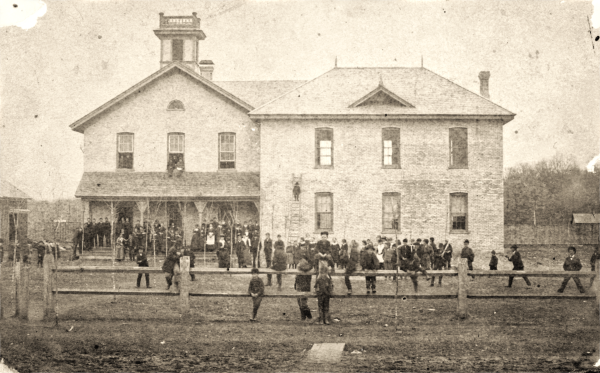
This white brick building was constructed in 1875. It stood on the site of the school building which now is being demolished on N. Union St. in Sparta. The photograph shows how it appeared in 1882.
With the cooperation and files of Mrs. Vernice Allen Courser, the following depicts a small portion of the history of the Sparta school system.
The first school in the Sparta area dates back to 1846 when Mrs. John (Harriet) Symes brought education to the young of the area. The site was in her home, a log house located about one and one half miles south of Sparta on the east side of the road.
In 1849, a small frame district school house was erected on Division Street approximately across the street from the Methodist Church. This small frame one room building with a wide entrance across the front, had a single row of seats (benches) on each side and two double rows of seats down the center. In 1862 the attendance became so great in the one room structure that the wide entrance was made into another room. Years later this building was moved to the corner of Division and Railroad Streets, more built on and made into a hotel. This building was later torn down with parts of the structure used in the present gas station now standing on the site.
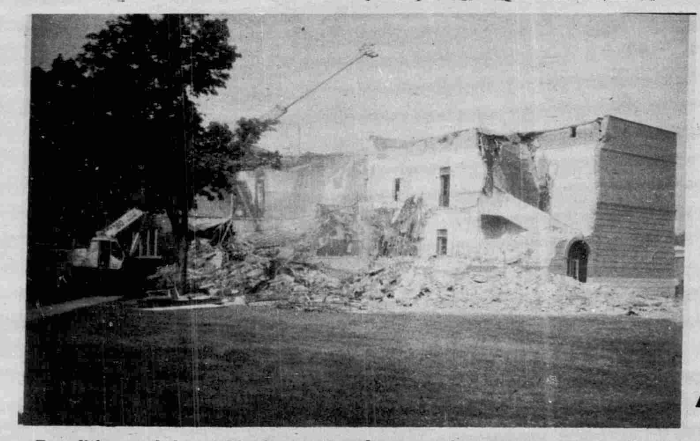
"Demolition work began Monday on the old school building adjacent to Sparta Central Elementary. Here a wrecker is shown in operation at the south side of the building near the end of work Monday afternoon. Demolition of the building, which was constructed in 1901 as the Sparta High School and was used in recent years for elementary school classes, revives many memories for former Sparta students. Cost to the school district for removal of the building is $16,000---the lowest of several bids received for the contract. Removal of the building will make way for additional playground area as well as providing for any future expansion necessary for the school system."--The Sentinel Leader and Comstock Park Courier-News, published August 12, 1970. The previous week's newspaper mentioned: "Approval was given by the Sparta Area Schools Board of Education Monday evening for the Cook Wreckers of Dorr, Michigan to remove the (old school) building."
Even during this time however, Mrs. Amherst Cheney was still teaching a select school over the Edwin Bradford store. This was located between the now Ben Franklin and Wolf's Drug stores and would be about where the street now lies. This store burned March 18, 1876, and with it burned all of the township records.
In 1875, the white brick building was erected on North Mill (Union) Street. This building was first composed of two rooms, one upstairs and one downstairs. In 1883 a wing was built on the south side of the building, which also had one room down and one above. In the year 1891, there were 90 pupils in the lower level of the original structure and it was then divided into two classrooms.
Two years later the Sparta school was changed to a full 12 year education plan with the class of 1894 being the first graduating class of Sparta High.
Some time between 1891 and the turn of the century, a small wooden frame building was erected south of the white brick building to house the lower grades. This building was later moved to the west end of Alma Street and used as a Swedish Church. It later became the home of Herbert Friske.
With enrollment swiftly outgrowing the old structure, the first section of the red brick building was erected in 1901. Nine years later, an addition was built on the south end of the red brick building to meet with expansion problems. In 1925 a gymnasium and several classrooms were added to the north end of the building, while in 1936-1937 another addition to the south added more up to date classrooms.
The first elementary addition to the building came in 1949-1950 with six rooms added on to the east side of the high school-junior high structure. In 1954 another addition was added to the elementary building for the lower grades. For the next 14 years, the central system stood at a standstill in the building program (although new facilities were definitely needed).
In the fall of 1959, Sparta High School students moved into their new million dollar building, with the upper level of the old school being used for junior high students.
With school enrollment still rising, the decision that the upper level of the old building was no longer safe for student use, greatly showed the administration that new facilities were once again needed. Thus ten years after the high school was opened, the new Sparta Middle School, for grades five, six, seven, and eight was opened. This building was erected east of the high school at the south end of Union Street.
Now in 1970, with additional classrooms being built onto both the grade school and also the new high school, the old red brick building is coming down.
Getting
Baehr Hugs
I have been getting Baehr hugs since 1952 for a lady I adored from the first minute I laid eyes on her. Miss Miriam Baehr, her name phonetically sounds like "bear", happened to have graced my young life at the age of eight years old. She was my third grade school teacher. Miss Baehr was also my first love. I came to her class in the old school building in November. I was a "transfer student". The rest of the class thought I was from Mars instead of a neighboring town.
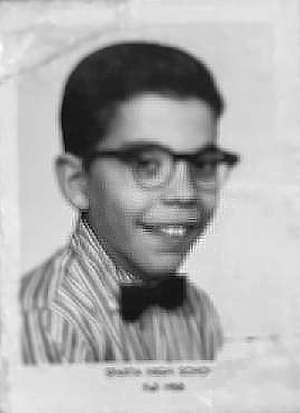
Anthony Falbe
I had a big mouth and was always talking. I was often found using profane language, not appropriate for an adult, let alone a child. I was the smallest kid in third grade. Only a few kids in kindergarten were smaller than me. I also possessed a temper. Miss Baehr never brought attention to my small stature, but would openly proclaim I had the fastest fist of any kid she ever saw. With these qualities, fighting was as natural to me as breathing. I also wore glasses and thought it great fun to color the lenses with my crayons. Drawing pictures on my desk, instead of paper, was also a favorite pastime.
I had a big problem with noon hour. No matter the weather, I enjoyed exploring the creek that was in the way of my getting back to school on time. The water held so much fascination with the unusual treasures I'd find there: I found a couple class rings and some real nifty moss covered bottle caps to stick in my bicycle spokes. Of course, in the springtime, little animals were abundant. In the winter, breaking the ice in the middle of the creek was most exciting. I liked hiking down the creek to the railroad bridge. I'd place pennies on the track, crawl under the bridge and enjoy the thrill of the train roaring over my head as it turned my pennies into "lucky pennies".
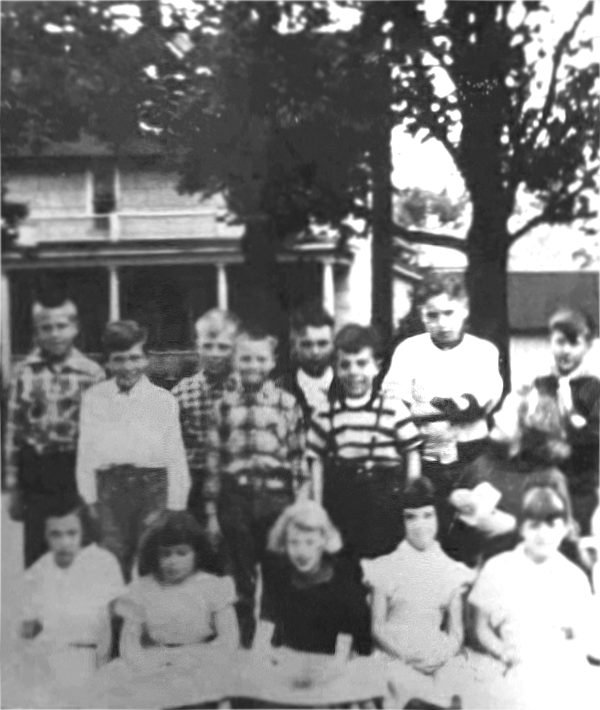
Anthony Falbe, in striped shirt, with third grade classmates. Adele (Bradford) Jones, center front
These fantastic adventures would bring me back to school an hour or so later, usually during phonics class. I was often soaking wet, very dirty, and certainly didn't smell too good. I hated Dick, Jane, and Sally stories. I loved Superman comic books. I hated spelling and penmanship, and still do. I really hated arithmetic, but I knew I could buy a hot dog and coke for twenty-six cents plus talk the waitress into putting a nickel in the jukebox to play my favorite tune Dragnet. History and geography intrigued me and I enjoyed art class, even if I did get messy.
Since I was a pint-sized thug, I wasn't allowed to go to recess often. Instead, Miss Baehr got ahold of a punching bag and would have me wail on it instead of another child. Miss Baehr came up with other ways to calm this savage. A face mask with Vicks vapor rub not only helped to keep my mouth shut, it also helped to clear up my clogged head and snotty nose that I usually had.
Miss Baehr gave me an old desk that had seen its better days. The other kids laughed at my old desk, but I loved it. I covered it with more graffiti to my liking. When we moved into the new room of the new addition, all of the other kids got brand new desks. I felt special because I got to keep my old desk. I could attack it at will with pencil, pen, or crayon with no repercussions.
Miss Baehr gave me a hand puppet to care for. He was a white polar bear. I'd play with him at my recess time, and put him to bed in my desk. I had to give up my pal at the end of the school year. I wonder how many other children ended up having a friendship with Frosty.
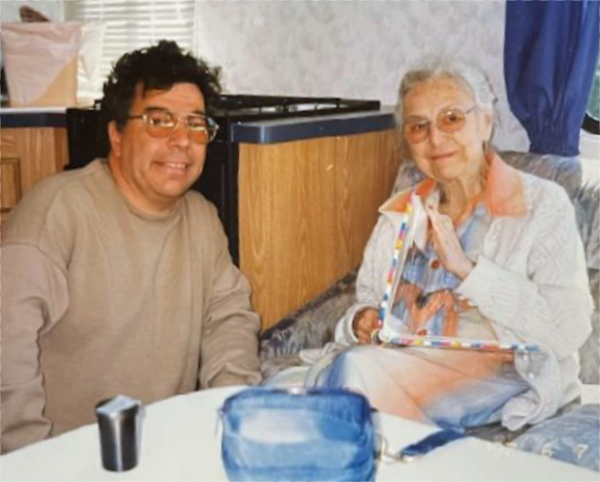
Anthony Falbe with Miss Baehr
Miss Baehr got after me one time and I shimmied up a drainpipe in the back corner of the room. I rested on a lip of the drain and refused to come down. Instead of getting excited, she just let me stay there. After awhile I needed to go to the bathroom real bad. I had to go so bad my hands were sweating. It's hard to do a potty dance while you're hanging onto a pipe. Finally, I slid down the pipe and made a mad dash for the bathroom. Miss Baehr came into the entryway of the bathroom to get me. She called me to come out. I was really scared but resigned to getting a severe beating. To my surprise, instead of hitting me, Miss Baehr gave me one of her famous Baehr hugs. She spoke gently to me and calmed my tears and fears.
When I joined the Cub Scouts, my mother could only afford to buy me a cap, neckerchief, and a shirt. I was so excited. I invited Miss Baehr to my home to see my uniform. I was so proud when she indeed showed up at my door. She came to our house another time and had a long conversation with my mother. At bed time, when Ma said "get to bed" my brother and I immediately said "good night" and went to our upstairs bedroom. This impressed Miss Baehr. She didn't realize until years later that our little ears were plastered to the heat register listening to the grown up talk.
Miss Baehr was firm, but gentle with her discipline. I was totally in love with her. I did my best to behave, even though I often was not successful. When Miss Baehr noticed I was trying my hardest, I'd get a Baehr hug. Sometimes she just noticed that I needed one just because I needed one.
Often, after I graduated from her class, I would come to see her. She would give me words of encouragement and let me know she was praying for me. Between her prayers and my love for her, I tried to make her proud of me. Miss Baehr came to my high school graduation which was another highlight of my life.
After the years passed, and even in my college days, I would find time to visit Miss Baehr and her third grade class. I love kids so I'd entertain them with my clown act and speech on safety and having fun. Miss Baehr would even let me go out to recess with them and play. Miss Baehr welcomed my returns and continued to give me encouragement. Sometimes I came to her home as an adult, discouraged and in despair. I would leave her home with a prayer on my heart, and best of all a Baehr hug.
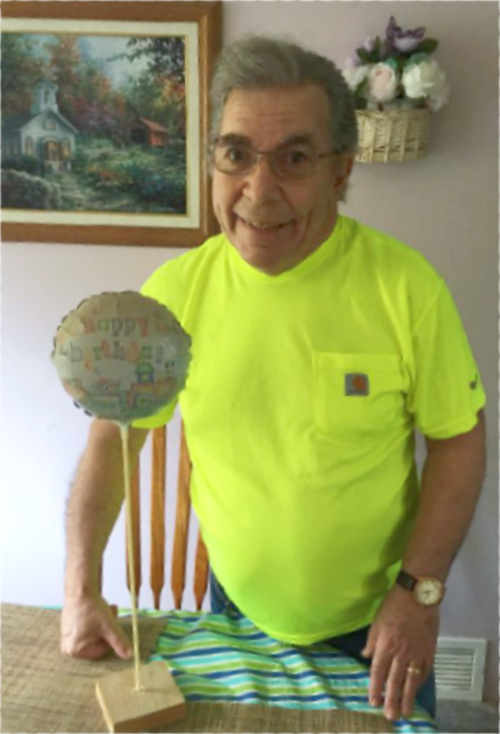
Anthony Falbe
I made a practice to see my beloved Miss Baehr as often as I could. We lived over one hundred miles away so those times were usually Thanksgiving, Christmas, and a few times during the summer. I have brought my wife, daughter, granddaughters, and 35 foster kids to her home. We've always left with uplifted hearts, a prayer of thanksgiving for God's love and a Baehr hug. Today, when I hug a child or an adult to give them comfort, it's not only from me, it is an extension of love and a Baehr hug.
Written on December 11, 1992 by Anthony W. Falbe
In May of 1995 Miss Baehr came to my 50th birthday party. She gave me a mylar balloon that resembled the punching bag she had me hit while in her class. What is remarkable is at this time, it is April of 2007 and that balloon is still fully inflated. It sits on top of my bedroom dresser.
I have been able to share this story at Miss Baehr's funeral, and also at a 40th class reunion. This story has also been shared with many other family and friends. I have been truly blessed to have felt the love of this fine lady.
Anthony (Tony) Falbe passed away on February 5, 2023.
Partly because of the lessons learned from his Sparta teacher, Miss Baehr, and their love for each other, Tony lived a life of service. He served in the Navy during the Vietnam War and became a Respiratory Therapist. He entertained as a clown named "Hubba Hubba Ding-A-Ling" to make people smile. It has been said that Tony had a heart of a clown. That heart not only projected humor but also compassion. He served within many organizations such as: Kiwanis, American Legion, American Red Cross, Michigan Heart Association, and a homeless shelter to name a few.
In Tony’s life, he continued to serve. He and his wife were foster parents for over 60 troubled teens. He said the biggest reward over the years was when they were all grown and came back to say “thank you”. Or having a past foster son come back for a weekend and spent time with our then current foster boys certainly rated as one of the best times. The toughest thing about raising foster kids is when they go down the wrong path ending up in prison. It is really mixed emotions when they say they love you from behind bars.
Tony once said he is sure the thing people will remember is that he colored outside the lines a little bit, but inside the lines he was very colorful. He wants to be remembered for his love of God, his love for family, and his love for his fellowman.
Tribute from a friend, Adele Jones
Fondly Remembered
Serving the educational needs of Sparta's public school students for 70 years, some 6,000 young people graced its hallways. Nostalgic alumni note the following features:
- Wide hallways with wood floors, full of squeaks - no sneaking up on anyone!
- High-ceilinged, spacious classrooms, walls painted in pale hues, studying under the ever-present gaze of G. Washington or A. Lincoln.
- A tomb-like basement, home to the boiler room, ag. class, shop class, and the tiniest locker rooms known to man. The "cage" holds your clothes in too-small metal baskets while taking showers under four shower heads in a tiny shower room leading down the hall to...
- A gymnasium the size of a Cracker Jacks box, a performance stage at the east end and a brick wall three inches from the out-of-bounds line at the west.
- The top story of this two-story plus full basement edifice featured a lecture/study hall/lunchroom in the building's northeast corner.
- Several composite graduation pictures displayed in 3' x 4' frames down some hallways.
- The most memorable feature of this red brick building's exterior was its fire escape tube, descending from that large study hall. It offered students a constant temptation to practice their egress skills, whether during the school year or over the summer.
One Hundred Seventy-Six
Years & Counting
Sparta Area Schools has enjoyed widespread support from its public for many of the 179 years of the township’s existence. Following are excerpts from two sources-the ‘brown book,’ the official record of Sparta’s 125th birthday in 1971 as well as a brochure created for the current high school’s grand opening in 2007. Changes to facilities since that year have also been added.--Larry Carter (2025)
The first school classes in Sparta Township were taught by Mrs. Harriet Symes in the late 1840s at her log house located about 1 ½ miles south of Sparta. There were few doctors at the time and frequently Mrs. Symes was called from her teaching to help with the arrival of new babies in the community. Her husband, John Symes, would teach for her.
Nash School, the first public school, was built in 1849 in Nashville-Sparta’s first name. This was a small frame, one-room structure with a wide entrance across the front. It was furnished with a single row of benches on each side and two double rows of seats down the center. One whole end of the room was blackboard. It was heated by a big, old-fashioned wood stove. Some students provided wood as part of their tuition. There was no kindergarten and, at recess, the boys and girls went out at different times to play. The building stood opposite the present United Methodist Church on Division Street. Years later, when no longer adequate for the increased enrollment, it was moved to the corner of Division and West Railroad (now South Elm), and became known as the Sparta Hotel.
Mr. Amherst B. Cheney operated a select school in the community. This was held above the Edwin Bradford store. It was located between the current location of Maddy LaRoue’s and Sparta’s Dime Store in the ‘50s through the ‘70s-now the beginning of South Union Street. A fire in 1878 destroyed the building and all of the township records. Mr. Cheney’s teaching was interrupted when he enlisted to fight in the Civil War in the 1860s. Students attending the select school paid their own tuition.
1875: First High School
The first high school was built of white brick in 1875 on North Mill (Union) Street. The first 12th grade class graduating was in 1894. A. Hamlin Smith and Rose Martindale were the first teachers in the school. Mr. Smith set the trees out in the schoolyard about 1880 on the day his son was born. The first school flag was purchased in 1888 when 214 pupils enrolled that year.
As the school population grew, a small frame wooden building was erected at the south side of the white brick building. Miss Maggie Finnucane taught kindergarten and the lower grades there. When the white brick schoolhouse was torn down, the small building was moved to the west end of Alma Street and used as a Swedish church.
The first graduating class prior to Sparta’s becoming a twelve-grade school was in 1881 and consisted of Hattie Thurston, Phiny Martindale, and Matie Olmstead. The class of 1894, the first to complete all 12 grades at Sparta, had eight students: Charles Hallack, Mable Ballard, Delbert Biddleman, Mattie Dart, L.D. Purdy, Lulu Hardy, Edith Davis, and Mae Sharp.
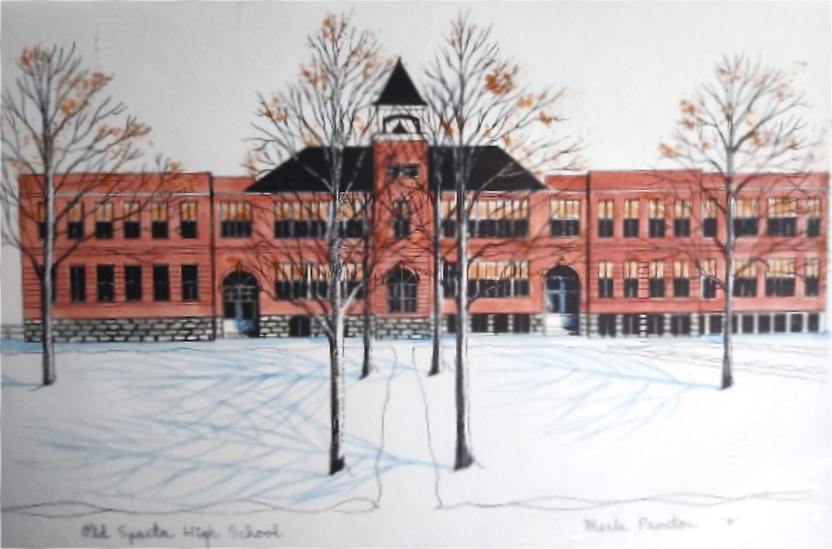
Painting of the 1901 red brick Sparta school by Merle Proctor.
1901: Second High School
A red brick school was built in 1901, the second high school, on the same site as the previous one. The first addition was built on the south side in 1910. In 1925, a gymnasium and several classrooms were added on the north side. In 1936-37, yet another addition was built on the south side, adding several more classrooms. Construction in 1949-50, then again in 1954, created an elementary school to the east of the high school building. The entire complex held kindergarten through 12th grade. The class of 1959 was the last graduating class from this school. The facility served the district another eight years as a junior high school, totaling 68 years of existence.
1959: Third High School
Ground was broken for a new (third) high school on South State Street in 1958. In the fall of 1959, high school students moved into their new $1.3 million facility and seniors became the first graduating class of 1960.
Following a nationwide trend toward consolidation for more efficient and effective educational services, Sparta Schools annexed 14 rural schools in 1956 and 57. After the annexations, the Sparta Public Schools officially became Sparta Area School District on April 23, 1957.
Continued growth in the Sparta area soon made it necessary to build a new middle school. It was completed in 1968 at a cost of $1.5 million. Located east of the high school, this building housed 5th through 8th grades and even 4th grade for a short time. Demolition of the old red brick building on North Union in 1970 made way for yet another elementary addition on the site. This campus was sold to the village and the 2007-08 school year was the last for public education on this site.
Ridgeview Elementary, directly southeast of this new high school, was built in 1992 and has housed 2nd through 4th graders through 2007-08. It became a K-2 grade building in 2008. 3rd through 5th was moved to the remodeled middle school, making it Sparta’s upper el building, Appleview Elementary.
2007: Fourth High School
The 4th Sparta High School opened in 2007. It was built as a state of the art, modern facility and features a 618- seat performing arts auditorium. 2020-21 marked the opening of a new middle school located northwest of Appleview Elementary, on grounds that previously featured Sparta’s baseball and softball fields for 50 years. The 1959-opened high school operated as a high school for 47 years, as a middle school for the next 13 years and was repurposed in 2021 as the Sparta Early Childhood Center, a beautiful facility for the youngest of Spartans.
Friends On The Bench
By Larry Carter
How do you preserve history, take a part of your collective past and bring it back? It helps if someone digs up a remnant of your youth-that’s what Dan and Rhonda Bissonette did. Rhonda’s childhood home on Alma Street in Sparta unearthed eighteen foundation stones from the iconic red brick Sparta High School building on North Union Street. Her folks, Irv and Shirley Johnston, got permission to haul these stones across the street to their yard, where they presumably would plan a pathway, a patio, some type of outdoor enhancement. But like so many projects we all plan, it did not come to fruition. Fifty-one years later, appreciating the stones’ historic value, Dan asked me if the Historical Commission might be interested in using these stones in some way.
My wife and I discussed this and thought it fitting that the stones be returned to Sparta Area Schools. While running the thought past and getting permission from STHC commissioners, we felt the need to turn these stones into something, and display that something on the current high school grounds. After dismissing my first thought of creating a mini-Stonehenge there, I moved on.
Something practical was needed-utilitarian, useful to all parties, not just for high school and jr. high alumni from the aughts through the 1960s. I had to sit and think about it. Recalling the Tribune Tower on a recent trip to Chicago where historic stones from all over the world were incorporated into the building’s design. I decided we would build a historic bench incorporating the foundation stones. And it had to be named The Old High School Bench.
Someone to conceptualize eighteen foundation stones into a park bench in a park-like setting was the task of Marlies Manning of Manning Design. An agreeable administrator was needed who could visualize the old with the new. High School Principal Stacey Rumsey saw a space in front of the current high school as the most appropriate setting. How about someone local who could craft the stones into useful outdoor furniture, maybe one who’d built a stone fireplace or two before. Jim Knauf of JK Masonry, and more recently Brickhaus Brews, stepped up to donate his expertise. And a metal crafter to create a comfortable sitting space, blending in with the surroundings-Phil Goodman of PM Designz.
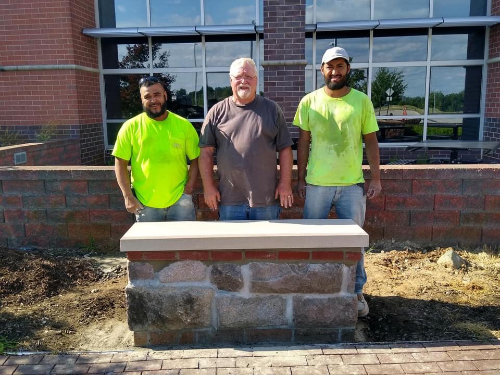
The men who built the bench
A local project is best put together with local help and this was the case with one exception. The display pedestal, to tell the story in an engaging and attractive way, became the task of Pannier Graphics from Gibsonia, PA. Beautifying the grounds was most naturally taken on by our own Sue Blackall who prepped and landscaped the area after the bench was put in place. A web designer who connected the story of the bench to the larger story of public education in our fair village was taken on by Sparta alum Loretta Bristol Baughan. She added a QR code at the bench site to the Sparta Township Historical Commission (spartahistory.org) website and a second code from the website back to the bench’s location. Loretta also informed me that she was part of a lonely 4th grade class, one of a few, if not the only class inhabiting the old building in its last year of existence, 1969-70. How interesting is that!
Behind any worthwhile project comes in-kind labor and generous funding. Sparta Historical Commission Friends and the SHS Class of 2022 provided funding to make the project a reality. So many moving parts that all came together, and on time! Thanks to those involved, particularly specific friends on the bench!
Bench Dedication held August 20, 2022
Larry Carter's concluding remarks
This building, opened in 2007, is the 4th high school to serve Sparta students since 1875 when the first two-story building was erected to include high schoolers. John Paul 'Sharkey' Badgerow (SHS Class of 1943) gave each of his classmates a brick out of the second high school at a class reunion a number of years ago. I was always impressed by that and lament that there's not more memorabilia from that cool old building.
Marcus Aurelius said, "Time is a sort of river passing events, and strong is its current; no sooner is a thing brought to sight than it is swept by and another takes its place, and this, too, will be swept away." Well, Jim Knauf assures me that this bench will not soon pass away. Right, Jim?
So now it's ours, containing the memories that we, our parents, grandparents, or great-grandparents, held during our jr. high or high school days in Sparta. May it stand as a testament to the importance that we place on gathering places for public education - starting some 147 years ago. Thank you for coming out this morning.
A Piece of History

Where's the Bench? Scan the QR code to find it.
Eighteen massive foundation stones salvaged from the old high school's demolition over fifty years ago have now come full circle. It's been a long journey from the distant past but just a short trip across our fair village and now this monument serves to link our history with the future.
By means of thoughtful consideration, the location chosen for The Old High School Bench is at the new Sparta High School. It can be found southwest of the building's main entrance at 475 W Spartan Drive, which is west from South State Street and just north of 12 Mile Road.
More than 120 years after they were quarried, carefully selected, skillfully cut, and set, it seems entirely befitting for this unique handcrafted bench to be placed where these stones will, once again, stand sentinel for new generations of Sparta High School students to appreciate their significance and... perhaps... even pique visitors' interest to discover more about our history.
Pay a visit and sit awhile.
The Sparta
That Once Was
While building the Railroad page for this website, I came across a remarkable news item about an accident which involved a little girl who fell asleep on the railroad track near her home, just north of Sparta. In the process of researching the article, Little Nickolai Girl Wanders onto Train Track, I located a family descendant, Karl Nickolai, who graduated from Sparta High a year after I did. He graciously provided photographs and family recollections, which brought the fascinating story to life. Through the process, I learned of his avocation of collecting old Sparta postcards, photographs, and other hometown memorabilia. Since then, he kindly provided rare items from his collection to help illustrate other articles.

A Sparta Historical Friends fund raiser with copies available at our May 17 book release or by request. Mail us at: Sparta Historical Friends, P.O. Box 163, Sparta MI 49345 or email (below). Order your book today and support Sparta history!
On a visit to Sparta, Karl connected with the Sparta Historical Friends President Larry Carter and Jim Lyals--and to make a long story short, a seed was planted. Soon, the idea grew and blossomed into the project of creating a large format book of rare postcards descriptively entitled, The Sparta That Once Was, to be used as a fund raiser. I was invited onboard and the four of us went to work selecting images from Karl's collection and the Sparta Township Historical Commission's archives.
Utilizing high resolution scans, Karl was able to enlarge antique postcards to either a full page 9x12 or facing page 9x24 panoramic views. He then tackled the job of meticulously dust spotting, repaired damage from age, careless handling, and otherwise cleaned up every image into pristine condition. As he handed each file off to me, I used my background in professional photography to adjust exposure, brightness, contrast, color, saturation, and focus. The original sepia coloration found in these old photographs varied from warm, rich browns to yellows, surprising oranges, and even subtle green tones. Some of the later black and white images had cooler blue tones. It was my goal to preserve and enhance these variations. I also had the task of design and prepared the book for publishing at Jeff Christians' Print Metro in Sparta.
Video provided courtesy of professional videographer
Dan Salas. His youtube channel includes dozens of
Sparta videos at Positively Michigan.
Meanwhile, Jim and Larry publicized the project, promoted it, and handled pre-release sales. The duo also organized the Book Release event to be held on Friday, May 17th, at 6:30 PM at the Sparta Civic Center, 75 N. Union. The public is invited. Those who have purchased copies already will receive theirs that evening. Additional copies will be available for purchase at the early bird price of $20. As of May 18th, the price will be $25 and shipping is an additional $5, if needed. Proceeds from the sale of The Sparta That Once Was supports the work of the Sparta Historical Friends, a non-profit that provides grants for numerous STHC activities to preserve and promote our history.
The result of our efforts is a nostalgic and extraordinary book that will captivate the imagination of young and old, alike. It's a wonderful glimpse into The Sparta That Once Was. "I know that my four fellow collaborators feel the same way as I do-we want the pictures found here to be a source of delight to all who take them in," reflects Larry Carter. "Enjoy-it is a page turner."
Yesterday's Treasures 2024
Set aside Friday, November 15, at 6:30pm, to look back at outstanding activities in Sparta in 2024. Conclude with a look forward at next year. And sandwiched in between, hear a Township retiree opine on her near half-century serving the book-loving public.

Mark your calendar for Yesterday's Treasures, a Sparta Historical Friends presentation on November 15, 2024, at 6:30 PM
Dan Salas brings his filmmaking artistry to a look back at this year’s Town & Country Days, held in May this year. The weather cooperated wonderfully for an outstanding weekend!
From there, experience what our small town looked like ‘back in the day’ as we see the rollout of The Sparta That Once Was, the Sparta Historical Friends offering to history-loving residents.
We’ve put together a short clip emphasizing the purpose for our annual Memorial Day Service at Lamoreaux Park. In another tribute to veterans, in its 10th year, the early September Freedom Cruise once again wove its way through Sparta in an area-wide tribute to fallen troops.
A large group of ‘Good Old Boys’ gather the 3rd Thursday of each month, and the whole point is fellowship and supporting one another. Lots of Sparta history, lots of facts and probably some fiction, is tossed around the long table at the Garden Patch! Sue Blackall from the Sparta Education Foundation interviewed a number of the guys and Dan recorded their activities.
Apple Fest, and all the activities that came with it, celebrated Nature’s bounty in late September as a bumper apple crop began to be harvested.
We then celebrate an institution retiring from an institution. Deb Poling, after 46 years, has retired from Sparta Carnegie Township Library. Hear her sentiments in a career-ending interview.
Finally, plan for next year as the Sparta Township Historical Commission offers the documentary Ag In Sparta Township, projected to air in late 2025. This will be a wide-ranging look into the local-and versatile-agriculture industry. It happens all around us, yet goes little noticed and little appreciated.--submitted by Larry Carter
SHC Friends
The Sparta Historical Friends exist to raise financial support through donations and grants to collect, catalogue, scan and preserve historical documents, film, buildings, and artifacts which illustrate the history of Sparta Township and its inhabitants.
Current Friends board members are: President Larry Carter, Ruth Bradford, Adele Jones, Toni Potes, Jeff Rogers, Dan Salas along with non-voting STHC member, JoAnne VanderWerff. We are pleased to announce our newest members, Bobbi Schirado, and Beckie Southwell, who came onboard in June 2024 and share our passion for history.
To a person, we are passionately advocating for and seeking to promote all things relating to Sparta history!
The Friends can be reached by email:
Contact
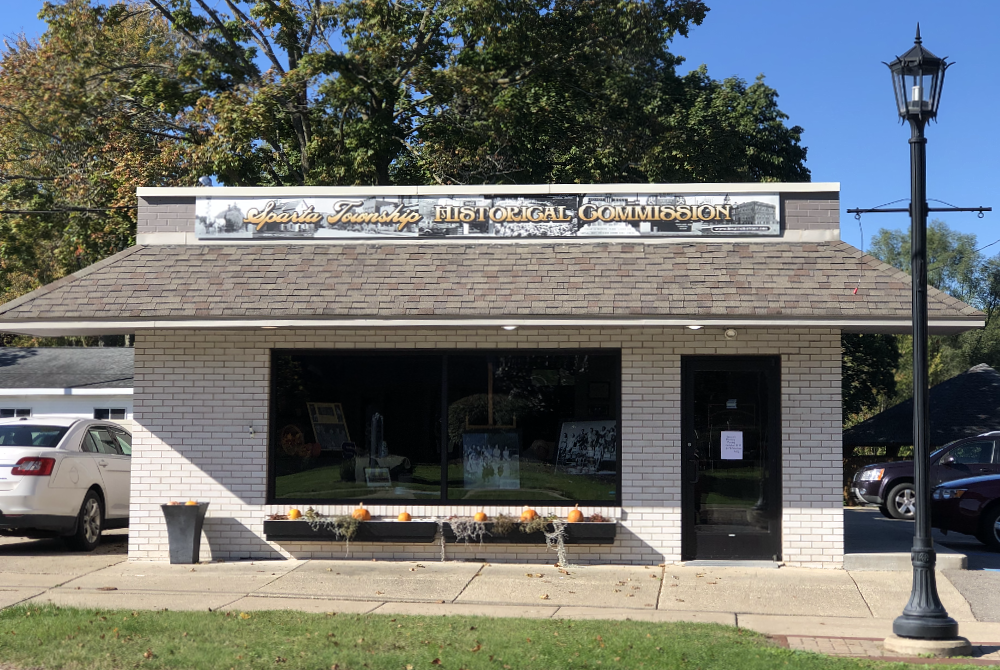
Sparta Township Historical Commission headquarters at 71 North Union Street
Our History Center is conveniently located at 71 North Union Street in downtown Sparta. Please join us for coffee and lively conversation on Monday mornings. Visits to the History Center can also be scheduled by appointment, for your convenience.
We do not receive mail at the History Center, instead, please use our mailing address, which is:
attn: Sparta Township Historical Commission
Sparta Township
160 E. Division St.
Sparta MI 49345.
Our complete archives are now available online for your convenience. Just click STHC PastPerfect Catalog Access and begin your research!
For other inquiries, the Sparta Township Historical Commission can be reached by phone at: (616)606-0765 or via email at the following address:
